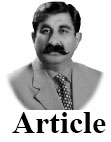NAVEED AMAN KHAN
MODERN Muscat truly reflects splendour of the Sultanate of Oman. Among several Muscat Air port is one of the most beautiful airports I have seen so far. Muscat City is very clean and well planned with marvellous road linkages. Continuous fascinating noisy Sea waves at AlSeeb and Matrah, Sultan Qaboos grand Yachts in the sea at Matrah, his grand palaces, old Souq Al Matrah bazar, antique shops, coffee shops, restaurants, shopping malls, Sultan Qaboos University, Sultan QaboosMosque, Nizwa and alot more attractthetourists from all over the world. Illiterate Omanis of half a century ago are well educated now. Badoos are seen civilised, cultured and groomed. Today in welfare State of Oman poverty is changed into prosperity. Dates growers of the past are now exporting oil, gold, marble and minerals. Calmness and peace prevails in the country you experience to visit. People here don’t fear theft or snatching. Life and property are completely safe. Law-abiding Omani nation of today surprises all. This is what Sultan Qaboos has given to his nation. To pay homage since the departure of Sultan Qaboos every daytens ofthousands ofOmanis and foreigners reach the cemetery he is buried in Bosher area. It shows because of his charisma people all over the world love and respect him. Not only Omanis but also world leaders highly respect his from the core of their hearts. During the first two years oftheTrumpterm, Sultan Qaboos bin Said,the great late ruler ofOman, confronted a stark situation, Iran-backed Houthi rebels were fighting on his doorstep in Yemen, Israel was attacking Palestinians andAmerica was largely giving up on diplomacy in the Middle East. Instead of playing at the back foot, the veteran leader did something different. First, he invited the Iranian president, HassanRouhani,to his palaceinMuscat.Then, he welcomed Prime Minister Benjamin Netanyahu of Israel and Yossi Cohen, the head of the Mossad, Israel’s spy agency, for a formal state visit. In almost any otherArab country today, hosting the leaders of both the Jewish State and the Islamic Republic would be unthinkable. For Qaboos who died on January 10 after running his country for 50 years this was simply a way of reinforcing Oman’s status as the region’s most ambidextrous conciliator. Qaboos was, for much of his long career, an indispensable linchpin of the international order. He often seemed like a throwback to another era. In Novembe 2019, Oman hosted indirect talks between Saudi Arabia and the Houthi rebels to try to end the devastating five-year war inYemen. Yet the greatest fruit of Qaboos’s diplomacy was the rapprochement he helped engineer between Iran andthe United States. The efforts began in 2009, just months after Barack Obama came to office.An Omani envoy offered to open a back channel to Tehran, and soon after, Oman negotiated the release of three American hikers detained in Iran. In 2012, top officials at the State Department began convening secretly with Iranian counterparts in Muscat to lay the groundwork for an eventual nuclear deal. Hassan Rouhani, amoderate pragmatist,was elected President of Iranin 2013. Qaboos, sensing an opportunity, promptly travelled to Tehran, becoming the first head of state to call on Rouhani. He also met with Iran’s supreme leader, Ayatollah Ali Khamenei. By year’s end, Oman’s ability to get top-level Iranian backing for the negotiations had smoothed the way for an interim agreement between Iran andAmerica and its allies. Now that the 2015 nuclear agreement has been formally abandoned by both the United States and Iran, and an assertive new generation of autocrats is taking over the Arabian Peninsula, it is far from clear whether the Omani sultan’s singular brand of cosmopolitan despotism can survive him. For Qaboos, there was no contradiction in finding common ground with both the leaders of Israel and their sworn enemies in Iran or Palestine, just as there was no contradiction between his unusually absolutist monarchy and the modern, liberal and highly diverse society he governed. While diplomats and rebel groups negotiated behind the scenes, Muscat was known for its internationally acclaimed opera house, which was inaugurated by Plácido Domingo and Franco Zeffirelli in the fall of 2011 at a time when the surrounding region was convulsed in protests. Oman had its Arab Spring, too, but it was carefully swept under the rug. A Marxist rebellion roiled the south, threatening to tear the country apart. With much help from Britain and the Shah of Iran, the young sultan handily suppressed the uprising. Then, exploiting the country’s oil reserves, he set out on a program of rapid development centred around schools, roads, hospitals and a strong assertion of Omani identity. Because of its earlier history as an Indian Ocean empire, Oman has an unusually diverse population, including large numbers of Balochis, South Asians and Swahili-speaking East Africans, and Arabs. Although it has a large Sunni population and a small Shiite minority, its predominant form of Islam is the much smaller, austere Ibadi sect, which tends to be politically quietist and tolerant of other faiths. By turning this distinct, mixed heritage into an overriding national value, Qaboos was able to unite a divided population now about 4.6 million strong under his modernizing regime. It helped that he also kept the country tightly in his grip, personally holding the portfolios of Defence Minister, Foreign Minister, Finance Minister, Prime Minister and Commander of the Armed Forces, and swiftly quelling any hint of religious extremism. By the 1980s, Oman’s “al-nahda,” or the renaissance as the country’s transformation is officially known was well underway, and Qaboos could apply his skills as unifier to foreign policy. During Iran-Iraq war, Oman maintained ties with both sides, and Sultan hosted secret peace talks. In the 2000s, Oman became particularly adept at bridging the ShiiteSunni divide, despite active membership in the Gulf Cooperation Council, alliance of Sunni monarchies that includes Saudi Arabia and the United Arab Emirates. — The writer is book ambassador, columnist, political analyst and author of several books based in Islamabad.









